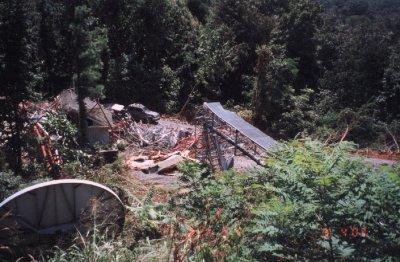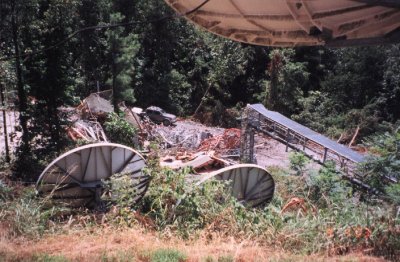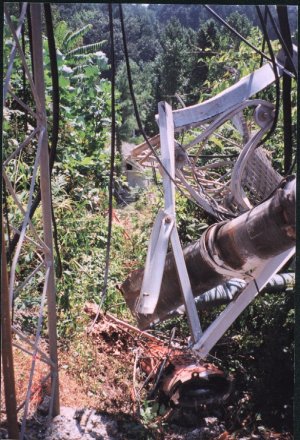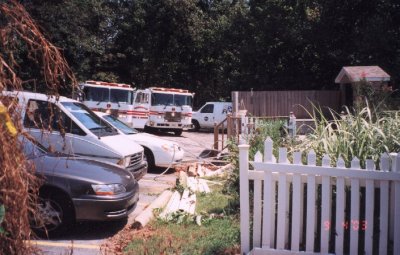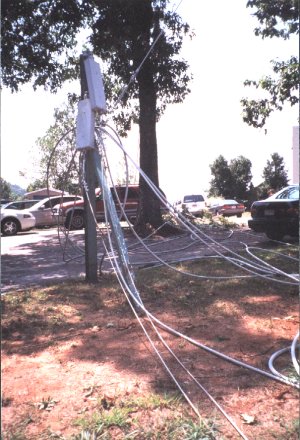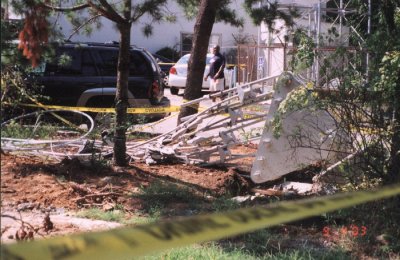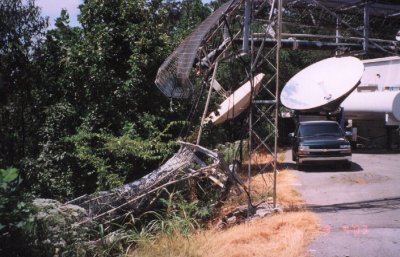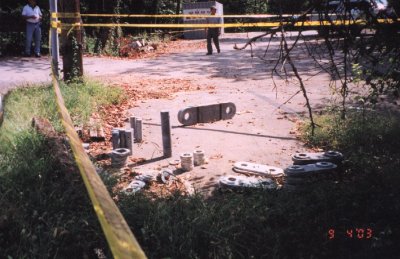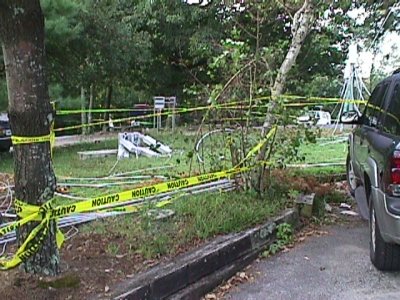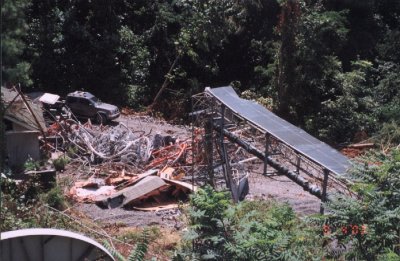
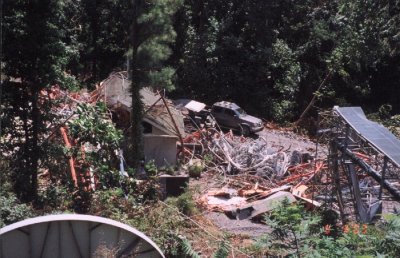
Workers from Spectrasite Communications had been working on the tower for several weeks to strengthen it for a different antenna (and probably feedline) that would multiplex transmitter signals from 31 and 54, digital and analog. A few years ago, GoCom had sold all the towers in it's chain to this tower company. This brought in capital and deals were struck to lease back the space for the TV station's antenna and feedline. Spectrasite was then free to negotiate with anyone for tower space, but to add all they planned to do, it was necessary to beef up the tower and anchors. Concrete had already been poured over an area of the guy anchors to strengthen them.
There were three workers on the tower (one may have been on or near the ground) at the time it fell, which was almost exactly 1:00 p.m. on Thursday, September 4, 2003. Among other rigging on the tower was a heavy "gin pole" which is used like a crane to raise heavy items up the tower and would also be the kind of thing used to take off the top 31 antenna, lower it to the ground, and re-install another antenna. The gin pole was said to weigh something in the neighborhood of 3,000 pounds and might be as long as 75 feet.
At the time the tower started to fall, Jim Boman and John Hain were outside working on a live truck or something. Jim said he heard a rumble and quickly glanced and saw the tower starting to come down. He quickly ran for the rear of the station to get away from the falling tower. As it turned out, none of the tower fell on the asphalt drive going around the side of the station to the rear of the building.
So the tower, due to some kind of mishap or accident, lost integrity and began to crumple down on itself. That is a very strong tower that has withstood several hundred thousand pounds of ice during ice storms, so it would be no small thing to make it fall. The tower had been well maintained over the years and anytime a routine inspection showed anything needing attention, it was corrected, replaced, painted or whatever it needed. As far as I know, there are no eye witnesses of exactly what happened to start the collapse. The tower collapsed within several hundred feet of the center pier. The GUYS ( not Guide wires as much of the press and media have stated) kept the tower from leaning in any direction and actually caused it to come down on itself in a very small area. The pylon antenna hit the transmission line run and ice-breaker structure closest to the station, but still on the tower side of the asphalt of the rear drive.
Two of Spectrasite's men were killed instantly and a third died in Huntsville Hospital shortly after. They were experienced tower men from Tuscon, AZ - Robstown, TX - and Hollywood, FL.
There was some talk about perhaps the guy wires might have been loosened for some reason, but the bolts I saw at the anchor threaded rods (the only place you could loosen the guy wires) did not appear to have been moved in many years. I don't believe that was a factor in what happened.
As the guy wires came down (and they are very heavy themselves) they did significant damage to cars and trees under them in the parking lot. It is fortunate no one was under the guys when the tower came down. In fact, no one at Channel 31 was injured at all. You can't tell much from the photos of twisted white and orange steel of the tower that is piled up on the ground. It looked like soft soldering wire that had been twisted and bent in all kinds of pretzel shapes.
There was a dog tied to the tree that belonged to one of the tower workers. He was untied and will be kept until claimed by a relative of the owner. The dog was not injured.
This tower was fabricated by Stainless, Inc. of North Wales, Pennsylvania and was erected by World Wide Towers, Inc. in 1976 into early 1977. With the new height and power (1.3 million watts ERP), we were able to secure the ABC TV network and changed over to ABC in December of 1977. The news ratings were also #1 and were a major factor in the network's decision to come to 31.
That station continues to operate on the old, small tower (errected in 1958) and antenna (An RCA TFU 24 DL, power gain of 24 that was put on the "little" tower in 1964, replacing a GE Helical that was not working well at all) that has been used as a spare for standby since 1976. It has been used several times in the past when work has been done on the pylon antenna (like replacing slot covers after a windstorm, replacing de-icing strips on the pylon antenna (the antenna itself is heated and won't collect ice, but the rest of the tower sure will) and painting the pylon). It operates at reduced power and height, but serves most cable companies in the coverage area with enough signal for a good picture. Some outlying fringe areas 70 miles away will not get a good picture until the new tower is built and antenna placed on it and made operational. I would guess 3-4 months minimum time.
On another note, the "RCA TFU 30-J-Special" antanna (power gain of 30) , was originally on our 400 foot tower that was built somewhere around 1970. The center base for the 400' tower is now the base the big satellite dish sits on outside the smoking lounge. Yes, that chunk of concrete (we poured more around the tower foundation to make the square base for the dish) was where the 400' tower was. And one of the guy anchors was in the parking lot asphalt, near the property line of ch. 19, just past the fence for the main sat dish in the front parking area near LiveStar. When we put up the 1,000 foot tower, we used the same antenna that we had on the 400' tower, but refurbished it on the ground before we put it up. We built the 1,000 foot tower around the 400' tower which we kept using, then took the antenna off and put it on the big tower, and proceeded to dismantle the 400' tower.
I had thought about keeping the 400' tower for a communications tower, but the Monte Sano Civic Association was not happy about the big tower, and only because we told them we'd take down the 400' one did they agree not to protest the permit we were seeking for the city to build the 1,000 foot tower. Another side note, our 50KW visual transmitter was to put about 45 KW of power into the antenna (figuring feedline loss) and that multiplied by 30 equals 1.35 million watts ERP (effective radiated power) to the viewing area. With beam tilt down towards the horizon (Florence) the FCC derates the ERP on the horizontal, but the antenna puts the power where it's needed and not into the distant horizon. (Talk to Cactus if you want to know more).
OSHA (the Occupational Safety and Health Administration) is looking into the industrial accident to see if they can determine the cause. It will be interesting to hear whatever conclusions they might draw at the end of their investigation. Photos I took of the scene follow below.

